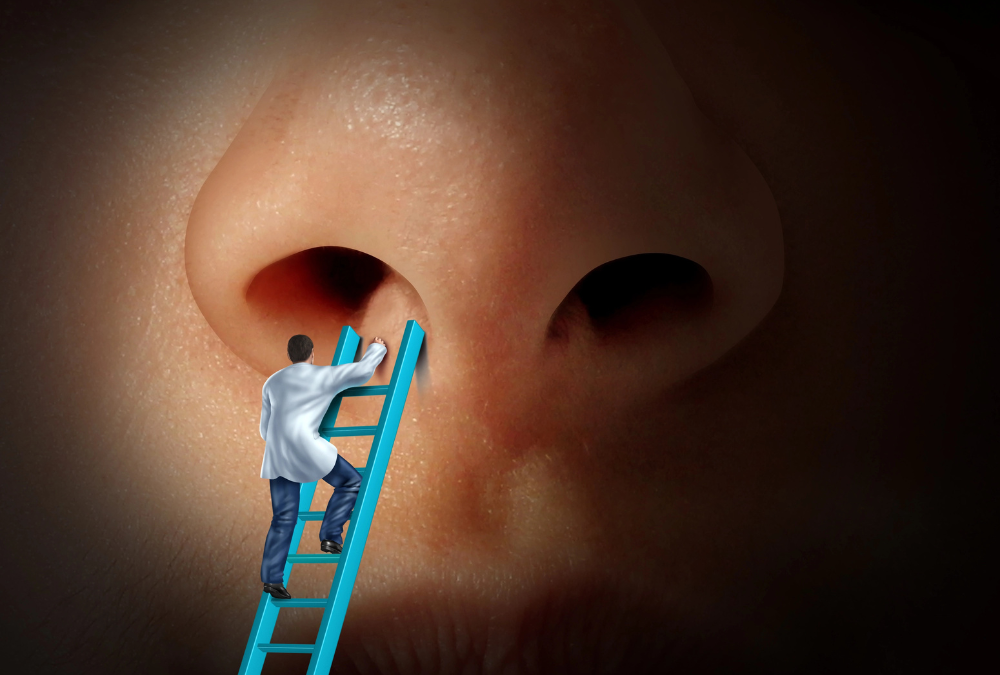While the majority of sinus or nasal issues stem from allergies, infections, or other common conditions, in some cases, persistent symptoms may indicate the presence of a nasal or sinus tumor. These tumors can be either benign (non-cancerous) or malignant (cancerous). Early detection plays a crucial role in successful treatment, so it’s important to understand the potential signs, causes, and treatment options for these tumors.
The sinuses are hollow, air-filled spaces located behind your nose, forehead, and cheeks, while the nasal cavity is the passageway within your nose. Tumors can form in both the sinuses and the nasal cavity, growing from the various tissues found in these areas.
Symptoms of Nasal and Sinus Tumors
Common Symptoms
- Persistent nasal congestion or stuffiness
- Sinus pain or pressure
- Frequent nosebleeds
- Decreased sense of smell
- Post-nasal drip
Less Common Symptoms
- Facial numbness or swelling
- Bulging eye
- Double vision
- Headaches
- Pain in the upper teeth
It’s important to remember these symptoms can also be caused by less serious conditions. However, if you experience any of these issues persistently, it’s essential to consult an ENT doctor in Irvine for a thorough evaluation.
Sometimes these symptoms tend to affect only one side of the nose or sinuses in the beginning. So, if you have congestion that doesn’t clear up on just one side, or a runny nose from only one nostril, that’s a sign to be especially mindful of.
Additionally, while occasional discharge from the nose is normal, if you notice discolored mucus (yellow, green, or bloody), especially in combination with other symptoms, it warrants seeing your doctor. These changes may indicate something more concerning than a regular cold.
Causes of Nasal and Sinus Tumors
While the exact causes of nasal and sinus tumors often remain unknown, several factors have been linked to an increased risk.
Environmental Factors
- Workplace exposures: Long-term exposure to certain substances in your work environment can put you at increased risk. These irritants include:
- Wood dust: People in professions like carpentry, furniture making, and lumber work are at higher risk due to the fine wood dust they inhale.
- Leather dust: Shoemakers and leatherworkers may be at risk.
- Flour: Bakers and those working in flour mills may inhale significant quantities of flour dust.
- Nickel and chromium dust: Metalworkers exposed to these metals might be at increased risk.
- Formaldehyde: Found in some building materials and industrial chemicals, formaldehyde is a known carcinogen.
- Other industrial chemicals: Research is ongoing about potential links between other chemicals and nasal/sinus tumor risk.
- Smoking and tobacco use: Smokers have dramatically increased risk due to the carcinogens in tobacco smoke. Even secondhand smoke exposure increases risk.
- HPV infection: Certain strains of the human papillomavirus (HPV) can infect the lining of the nose and sinuses, potentially leading to cancerous changes in cells.
Genetic Factors
- Family history: A family history of nasal or sinus tumors suggests you might have an increased risk due to inherited genes.
- Inherited conditions: Rare genetic syndromes like inverted papilloma are associated with a higher chance of developing certain nasal and sinus tumors.
Other Risk Factors
- Age: The risk generally increases with age, with most diagnoses occurring in people over 50.
- Gender: Men are diagnosed with nasal and sinus cancers about twice as often as women.
- Chronic Inflammation: Long-term sinus infections or inflammation (sinusitis) may also increase the risk of developing certain types of nasal and sinus tumors. While the exact link is still being researched, persistent inflammation can damage the cells that line the sinuses and nasal cavity, potentially contributing to abnormal cell growth.
- Weakened Immune System: People with compromised immune systems may be at a higher risk of developing some nasal and sinus tumors. A weakened immune system has lowered defenses against the growth and spread of potentially harmful cells.
Diagnosis of Nasal and Sinus Tumors

Imaging Tests: If the physical exam raises any concerns, imaging tests are necessary for a closer look. CT scans or MRIs provide detailed images of your sinuses and nasal cavity, helping to visualize any growths, their size, and their spread to surrounding structures.
Nasal Endoscopy: An ENT doctor in Irvine may use a nasal endoscope, a thin flexible tube with a light and camera, for direct visualization deep inside your nasal passages. This helps them examine areas that are difficult to see with the naked eye and aids in determining the best location to take a biopsy.
Biopsy: This is the most definitive way to diagnose a nasal or sinus tumor. A small tissue sample is taken from the suspected tumor and examined under a microscope. A pathologist will carefully analyze the cells to determine if they are cancerous, what type of cancer is present, and other characteristics that will guide treatment decisions.
Treatment Options for Nasal and Sinus Tumors
The ideal treatment plan for a sinus or nasal tumor depends on factors like the tumor type, size, location, and your overall health. Specialists at Orange Coast ENT Head and Neck Surgery offer expert care and may recommend one or a combination of the following approaches:
- Surgery: Surgical removal is often the primary treatment, especially for benign tumors or localized cancers. Orange Coast ENT offers advanced minimally invasive surgical techniques, including endoscopic sinus surgery, to remove tumors with as little impact as possible.
- Radiation Therapy: Uses high-energy beams to target and destroy cancer cells.
- Chemotherapy: Drugs are used to kill cancer cells or stop their growth.
- Targeted Therapy: Newer drugs designed to target specific changes in cancer cells, often offering fewer side effects than traditional chemotherapy.
- Immunotherapy: Helps your body’s own immune system fight against cancer cells.
At Orange Coast ENT, our ENT specialists will work closely with you to create a personalized treatment plan. We stay up-to-date on the latest advancements in treatment options, giving you access to the most effective therapies.
Sometimes, several treatment approaches may be used in combination. For instance, surgery to remove as much of the tumor as possible may be followed by radiation therapy to target any remaining cancer cells and reduce the risk of recurrence.
Our commitment doesn’t end with treatment. Orange Coast ENT specialists are your partners throughout the process. We’ll provide ongoing monitoring, helping to manage any potential side effects and promote your long-term health. Your well-being is our primary focus.
Conclusion
Early diagnosis and treatment of nasal and sinus tumors significantly improve the chances of a successful outcome. If you experience concerning or persistent symptoms, don’t hesitate to seek professional evaluation from an ENT doctor in Irvine.
Ongoing research in the diagnosis and treatment of nasal and sinus tumors offers hope for the future. Scientists are working to uncover new risk factors, develop better detection methods, and explore novel treatment options. As research advances, patients may benefit from even more personalized and effective therapies.
If you have concerns about your risk for nasal or sinus tumors, talk to your ENT doctor in Irvine. They can advise you on any steps you can take to minimize your risk and help you recognize potential warning signs that may require further evaluation.

